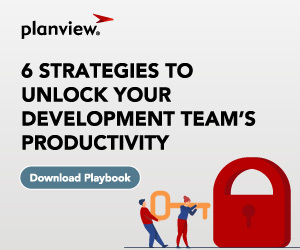
Change is never easy, and that holds particularly true with the tools people are accustomed to using in their day-to-day work. Even if that change is an upgraded all-in-one platform that can eliminate redundancies, integrate multiple tools, and solve persistent pain points. So how can you convince stakeholders to take a leap of faith and commit to switching platforms?
The good news is that you’re not alone. As more companies evolve to a digital business model, they’ll require increasingly sophisticated infrastructure to support their workflows. And the capabilities of toolchain integration are constantly expanding, so many companies will be going through the process of evaluating solutions.
In this blog, we’ll cover how to identify your key stakeholders affected by a new toolchain integration solution, how to present a solid business case, and why it’s time to swing for the fences and pitch an advanced solution.
What Is a Toolchain Integration Solution?
Simply put, a toolchain is a set of digital tools that enable product development by making complex tasks simpler and less error-prone and time-consuming. It should enhance communication and feedback between teams, offer simple visibility to ongoing processes and tracking, and support continuous delivery of products.
Building a successful toolchain is highly dependent on the needs of a particular organization and requires a heavy amount of resources, expertise, and time—which is why many companies opt for an off-the-shelf solution instead of building it themselves. Whatever you choose, a toolchain integration solution should make your product development pipeline smoother, faster, and more profitable.
Identify Your Stakeholders—and What Matters to Them
Before you get started, it’s critical to ask who’s going to be using this integration platform and what matters most to them. Identifying your stakeholders, as well as the problems an integration platform could solve for them, is critical to the success of any new technology.
At the end of the day, the best and most powerful platform around can be rendered functionally useless if no one’s using it to its full potential. So, it’s vital to determine what would incentivize stakeholders to make a change.
Every organization is different, but there are some common themes for getting platform integration buy-in. Listed here are six typical stakeholder types, as well as one of the most pressing concerns they commonly cite:
- IT Tools Team: The folks in IT who handle the actual implementation, integration, rollout, and maintenance of tech tools can be some of your best allies in seeking an upgrade. They’ll be looking for an all-in-one solution that reduces redundancies, eliminates errors, and doesn’t create tech debt by relying on outdated systems.
- Portfolio Management Office: Because the PMO is so deeply involved in strategic goals and resource allocation, they’ll be interested in solutions that eliminate misunderstandings between planning and execution, as well as tools that keep communication centralized and not siloed across multiple platforms.
- Engineering Lead: Scrum and Kanban boards, release schedules, and short-term sprints can all be better managed with a platform that provides integrated Agile capabilities, as well as easy access to visualization on project status.
- System Engineer: Teams involved in creating products will have several requirements to meet for prototypes, testing, reviews, and regulatory compliance. For them, an integrated tool that provides clear traceability and reporting—without multiple log-ins across several platforms—can make implementation cleaner and faster.
- Quality Assurance/Testing: QA testing might be relying on outdated manual tools to catch or resolve defects when they could be saving time with automated modern tools. Additionally, it’s ideal to have testing, defect logs, and resolution work limited to a single platform for better traceability.
- Service Desk: It’s much easier to keep tools running day-to-day if the service desk can track tickets and build an IT knowledge base in one integrated platform instead of siloing their operations across several locations.
Build and Present a Business Case
Once you’ve identified your stakeholders and their pain points, you’re ready to start building a business case for your pitch. Essentially, a business case refers to a compelling reason why your proposed solution will benefit the business as a whole.
Each organization will have different concerns, but try focusing on the critical use cases that highlight the existing problems, how those issues impact the business, and how an integrated platform can solve them. For example, if you work in a highly regulated or safety-related industry that requires strict documentation, you could discuss how jumping between disparate tools creates errors, wastes time, and compromises traceability.
If possible, collect everything into one file, whether that’s a document or a slide deck, that can be easily referenced and sent to stakeholders after the presentation.
Create an Argument for Why You Need an Advanced Solution
It might be tempting for you or your stakeholders to suggest using a free or low-cost solution instead of a more advanced integrated platform. And if your use cases point to simple, small-scale headaches, that might be appropriate. However, if you’re looking at complex issues that impact critical business functions, it might be better to invest in a comprehensive solution now instead of losing valuable time on low-cost options and eventually resorting to the advanced package later on.
To convince your stakeholders, consider these key benefits of using an advanced integration platform:
- Increased productivity. If you’re spending less time manually connecting systems, you’ll have more time for the tasks that really matter.
- Accelerated product development. Smart workflows and automated processes can speed up development timelines and allow for greater flexibility in making adjustments.
- Better cross-functional collaboration. Don’t settle for teams siloed in separate Slack channels or email chains — increase their ability to collaborate with an easy-to-use platform.
Dig Deeper into How to Get Stakeholder Buy-In
Ready to read more? Download Planview’s guide to achieving stakeholder buy-in for a toolchain integration platform. The guide addresses the five key areas needed to make your pitch compelling:
- Identifying your stakeholders and understanding what matters to them
- Building and presenting your business case
- Creating a convincing argument for why your organization needs an advanced solution
- Communicating the ROI your organization will achieve
- Addressing common stakeholder objections
It also includes workbook exercises that will help you think through each of these steps, as well as a downloadable Powerpoint template you can customize and use during your pitch. By the time you get through the guide, you will have prepared the basics of your presentation.




